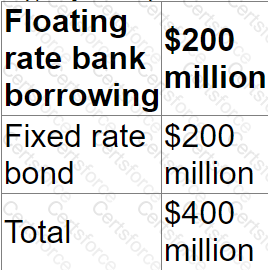Company X is an established, unquoted company which provides IT advisory services.
The company's results and cashflows are growing steadily and it has few direct competitors due to the very specialised nature of it's business. Dividends are predictable and paid annually.
Company P is looking to buy 30% of company X's equity shares.
Which TWO of the following methods are likely to be considered most suitable valuation methods for valuing company P's investment in Company X?
An unlisted company is attempting to value its equity using the dividend valuation model.
Relevant information is as follows:
• A dividend of $500,000 has just been paid.
• Dividend growth of 8% is expected for the foreseeable future.
• Earnings growth of 6% is expected for the foreseeable future.
• The cost of equity of a proxy listed company is 15%.
• The risk premium required due to the company being unlisted is 3%.
The calculation that has been performed is as follows:
Equity value = $540,000 / (0.18 - 0.08) = $5,400,000
What is the fault with the calculation that has been performed?
A listed company follows a policy of paying a constant dividend. The following information is available:
• Issued share capital (nominal value $0.50) $60 million
• Current market capitalisation $480 million
The shareholders are requesting an increased dividend this year as earnings have been growing. However, the directors wish to retain as much cash as possible to fund new investments. They therefore plan to announce a 1-for-10 scrip dividend to replace the usual cash dividend.
Assuming no other influence on share price, what is the expected share price following the scrip dividend?
Give your answer to 2 decimal places.
$ ?
A company is considering a divestment via either a management buyout (MBO) or sale to a private equity purchaser. Which of the following is an argument in favour of the MBO from the viewpoint of the original company?
A company is deciding whether to offer a scrip dividend or a cash dividend to its shareholders.
Although the company has excellent long-term growth prospects, it is experiencing short-term profit and cash flow problems.
Which of the following statements is most likely to be a reason for choosing the scrip dividend?
An entity prepares financial statements to 30 June.
During the year ended 30 June 20X2 the following events occurred:
1 July 20X1
• The entitiy borrowed $100 million at a variable rate of interest.
• In order to protect itself against the variability of its interest cashflows, the entity entered into a pay-fixed-receive-variable interest swap with annual settlements. The fair value of the swap on this date was zero.
30 June 20X2
• The entity received a net settlement of $2 million under the swap. After this net settlement, the fair value of the swap was $5 million - a financial asset.
The entity decides to use hedge accounting for this arrangement and has designated it as a cash flow hedge. The swap is a perfect hedge of the variability of the cash interest payments.
Which of the following describes the treatment of the settlement and the change in the fair value of the swap in the statement of profit or loss and other comprehensive income for the year ended 30 June 20X2?
A company is in the process of issuing a 10 year $100 million bond and is considering using an interest rate swap to change the interest profile on some or all of the $100 million new finance.
The company has a target fixed versus floating rate debt profile of 1:1. Before issuing the bond its debt profile was as follows:

Which of the following is the most appropriate interest rate swap structure for the company?
A company currently has a 5.25% fixed rate loan but it wishes to change the interest style of the loan to variable by using an interest rate swap directly with the bank.
The bank has quoted the following swap rate:
* 4.50% - 455% in exchange for Libor
Libor is currently 4%.
If the company enters into the swap and Libor remains at 4%. what will the company's interest cost be?
A company has accumulated a significant amount of excess cash which is not required for investment for the foreseeable future.
It is currently on deposit, earning negligible returns.
The Board of Directors is considering returning this excess cash to shareholders using a share repurchase programme.
The majority of shareholders are individuals with small shareholdings.
Which THREE of the following are advantages of the company undertaking a share repurchase programme?
A company generates operating profit of $17.2 million, and incurs finance costs of $5.7 million.
It plans to increase interest cover to a multiple of 5-to-1 by raising funds from shareholders to repay some existing debt. The pre-tax cost of debt is fixed at 5%, and the refinancing will not affect this.
Assuming no change in operating profit, what amount must be raised from shareholders?
Give your answer in $ millions to the nearest one decimal place.
$ ?